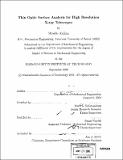Thin optic surface analysis for high resolution X-ray telescopes
Author(s)
Akilian, Mireille
DownloadFull printable version (12.80Mb)
Other Contributors
Massachusetts Institute of Technology. Dept. of Mechanical Engineering.
Advisor
Mark L. Schattenburg and Samir Nayfeh.
Terms of use
Metadata
Show full item recordAbstract
The art of glass developed throughout the years has covered artifacts ranging from crude ornaments to high precision optics used in flat panel displays, hard disk drives, and x-ray telescopes. Methods for manufacturing glass sheets and further sheet shaping processes are covered. Future generation, high resolution x-ray telescopes require thin optics with large surface area to thickness ratio and a surface flatness of -500 nm. A novel method utilizing porous ceramics, which provide a thin layer of air for sheet glass to rest on during the shaping process, is investigated. The shaping process involves slumping glass on a uniform layer of air at elevated temperatures, where the viscosity of glass is low enough for it to sag under its own weight and replicate the surface it rests on. Flow in porous, rectangular air bearings is covered with both flat and grooved surfaces. The pressure distribution in the air gap between the ceramic and the glass sheet determines the surface quality of glass during slumping. The mechanical integrity of porous ceramics at elevated temperatures is investigated to predict the effect of the decrease in ceramic stiffness on the final shape of the optic. (cont.) A metrology truss used to kinematically constrain thin optics during metrology is designed. This device mitigates the effects of external forces, such as gravity, friction, and thermal stresses, induced on the optic while being mechanically constrained, thus significantly improving the repeatability of the optic surface map measurements.
Description
Thesis (S.M.)--Massachusetts Institute of Technology, Dept. of Mechanical Engineering, 2004. Includes bibliographical references (p. 119-122).
Date issued
2004Department
Massachusetts Institute of Technology. Department of Mechanical EngineeringPublisher
Massachusetts Institute of Technology
Keywords
Mechanical Engineering.